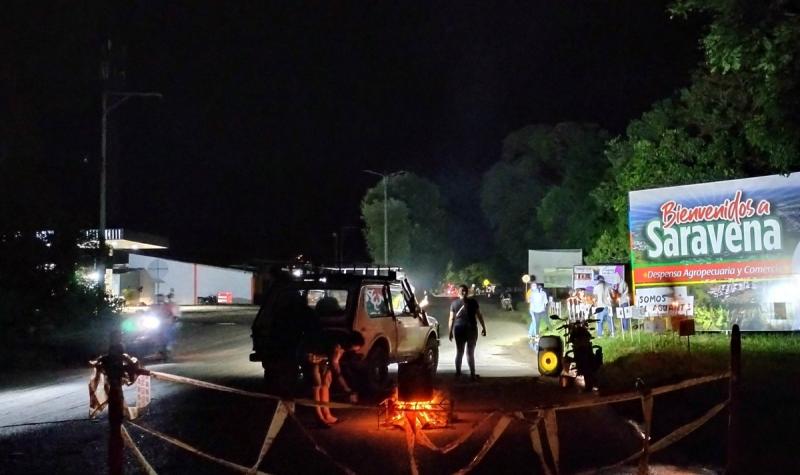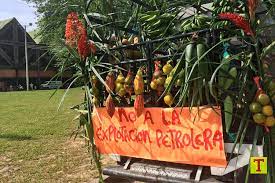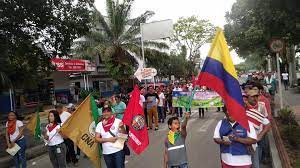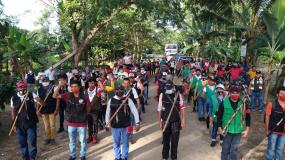As we finished writing this article, three people were assassinated in the city of Saravena, making 67 official massacres in Colombia this year. This article is dedicated to the victims.
A complex geopolitical region
Saravena, Arauca department, 22 July 2021. With no explanation given, we are taken to a room in a community building to wait. It’s nothing out of the ordinary in this region of Colombia, where daily experience of a “red zone” in the armed conflict teaches people not to confide in new arrivals. A historical stronghold of the National Liberation Army (ELN), Arauca is inescapably a geostrategic zone of prime importance. It borders Venezuela, from which it is divided by a narrow river. Tensions along the border are acute in a context where the Colombian government’s foreign policy serves as a stalking horse for US interests in Latin America. Colombia is a geopolitical satellite of Washington and one of a dozen members of the Lima Group, which seeks the overthrow of the Venezuelan government. Its nominally socialist neighbour has become an enemy by proxy in a play of alliances harking back to the Cold War. The department of Arauca is also known for its natural resources, including petroleum, and these prizes have slaked the greed of other “conventional” parties to the armed conflict, with the FARC-EP and the paramilitaries jumping into the melee to carve out a piece of the pie. In the midst of this chaos, the civilian population finds itself taken hostage.
After waiting for some time, a young woman, her hair parted in the centre into two meticulous braids, introduces herself and shakes our hands with a wide smile. After a few formalities, Sonia, a highly respected social movement leader in the region, embarks on an insider’s history of Arauca. “Our department is the outgrowth of a colonization process taking place throughout Colombia in the late 1960s. Many peasants fleeing from terror during the period known as La Violencia took refuge here to work the land.” Arauca was not exactly Eden for these landless, poverty-stricken people, as they confronted paramilitary violence and found themselves at the mercy of big landowners. Added to that were the hardships of daily life in a country where the government provides almost no essential services, not even drinking water. These displaced masses embarked on a long and historic process of organization, initially giving rise to the civilian strike of 1972, when some 162,000 workers across the country went on strike. The ensuing power struggle with the government led to the signing of a set of agreements for the provision of basic public services. Unsurprisingly, these agreements were never upheld, and a second strike was held ten years later to remind the government of its responsibilities. The movement was ultimately consolidated in the form of the Sindicato Unido de Saravena.
 Every struggle provokes a reaction, and those same years coincided with a significant increase in repression of the social movement. The “security” derived from repression made for a region coveted by the Occidental Petroleum Corporation when it learned of valuable reserves in the department and wanted to be assured, before setting up operations in 1983, that it would not be troubled by crowds of demonstrators. Occidental’s arrival touched off an oil boom unprecedented in the history of the region. Once a neglected and unknown department, Arauca’s name was now on the map. People moved there from all over the country in search of employment. However, this high-tech industry had jobs to offer to only a few, with the rest remaining for the most part unemployed.
Every struggle provokes a reaction, and those same years coincided with a significant increase in repression of the social movement. The “security” derived from repression made for a region coveted by the Occidental Petroleum Corporation when it learned of valuable reserves in the department and wanted to be assured, before setting up operations in 1983, that it would not be troubled by crowds of demonstrators. Occidental’s arrival touched off an oil boom unprecedented in the history of the region. Once a neglected and unknown department, Arauca’s name was now on the map. People moved there from all over the country in search of employment. However, this high-tech industry had jobs to offer to only a few, with the rest remaining for the most part unemployed.
By 1986, environmental damage and unemployment had taken their toll and public discontent with the company had become widespread. Thousands of marchers descended on the Caño Limón pipeline in the town of Arauquita in an initial attempt to expel the company. According to Sonia, “This was a change in the nature of the struggle; now instead of merely enunciating our demands, we moved into long-range political organizing in the region.” What this shift meant for the social movement is that it had to become politically autonomous. Where the citizens had previously been trying to get the government to acknowledge their demands and play its role accordingly, autonomous political struggle meant directly building alternatives under the aegis of the popular movement (or what is called “people’s power” (poder popular ) in this country). In this second paradigm, while the government is of course asked to do its duty and demilitarize the territory, it is no longer treated as a legitimate interlocutor. “We expect nothing from the government,” says Sonia firmly.
This analysis of the government as a class enemy is definitively corroborated by a consideration of its complicity with drug traffickers and far-right paramilitary groups. In Arauca, numerous massacres attest to this close relationship. In November 1998, soldiers of the national army occupied the district of Cabuya in the town of Tame around 6:00 PM. At 11 o’clock or thereabouts, this “courtesy” operation turn into an outright massacre in which soldiers allied with a paramilitary group called the Masetos killed five people and displaced more than 34 families. A seven-months-pregnant women was raped and decapitated. On December 12, an army helicopter supposedly conducting a strategic maneuver against a FARC front fired indiscriminately on the neighbourhood of Santo Domingo killing 17, among them seven children. But these more spectacular massacres should not make us forget the more invisible ones happening every day. In Arauca, police collusion with organized crime is such that stories of people being murdered by hitmen (sicarios) at the doors of police stations are commonplace.
As if that were not enough, the backdrop to this social conflict is that of skirmishes for control of the territory between the main left-wing armed groups, the FARC-EP and the ELN. The first of these has become cut off from its base of support and sunk progressively into a logic of militarism, prioritizing military conquest over building a grassroots following. Control over territory thus becomes a crucial issue, since it allows the group to increase the “revolutionary tax” and hence its war prize. For the FARC, there was no room for more than one guerrilla group on this territory and it gave the ELN an ultimatum: either join forces or leave. The period between 2005 and 2008 saw the conflict between these two groups reach a paroxysm and many civilians displaced or killed. Outside the armed confrontation, the guerrillas were known for frequently attacking the social movements historically associated with their rivals. In this community building, where Sonia recounts these frightening years, 150 people fleeing the violence provoked by the intra-left dispute were accommodated for a year. To address the housing shortage, whole neighbourhoods were built in haste on the edge of Saravena to house displaced persons who could no longer go back to their land, pending a lull in the conflict. Finally, after a formal demand by the civilian population in 2008, a series of agreements between the FARC and the ELN led to a nonaggression pact containing a civilian immunity clause. This pact allowed for the gradual return of many displaced persons to their homes.
In a context where peace is made not by the signing of great governmental treaties in presidential palaces but as a result of efforts by the civilian population, other measures were taken to secure a semblance of political stability. A decision by the national peasants’ association (ANUC) was to change the course of the armed conflict in Arauca for the better. Colombian peasants faced a dilemma: either let half their yucca harvest rot instead of selling it at the price determined by corporate trade agreements, or plant coca, enabling them to derive some income from the drug trade. Given this dilemma, the 2008 ANUC general assembly opted for total eradication of coca leaf growing in the Arauca region, in an effort to erode the material basis for drug trafficking. By diverting farm resources to traditional peasant crops such as plantain, coffee, and cacao, the decision had the indirect effect of driving out the drug traffickers. Nevertheless, the job of converting an illicit economy into a strictly agricultural one is arduous, since 70% of the region is devoted to oil and gas mining.
Self-management in Saravena
The day after arriving in Saravena, we meet several individuals involved in the social movement who offer to give us a tour of various local projects and community associations, of which Saravena apparently has a great many. One of these is a large community-based, multi-faceted public utility known as ECAAAS (Empresa Comunitaria de Acueducto, Alcantarillado y Aseo de Saravena). We are warmly welcomed by its president, a man named Bernardo. Visibly enthusiastic about presenting the project’s successes, he entertains us at length about its origins. Decades ago, as Sonia had told us and as Bernardo reiterated, the Colombian government found a pretext for achieving its long-cherished goal of abandoning rural areas to the private sector: Law 142 of 1961. Under this law, the state was no longer responsible for public utilities, and the result was to guarantee the supremacy of the private sector, monopoly formation, and drastic price increases (pace the proponents of “the invisible hand of the market”). The private sector found it “too costly” to supply the department’s towns with drinking water, as if such decisions should be based on accounting considerations and not fundamental rights. ECAAAS arose as a people’s initiative to fill the void left by the state, since by the 1970s, the city still lacked a water supply system. Several years later, the plan was put into effect. The infrastructure serves more than half the urbanized area of Saravena and also treats its wastewater. The water supply is monitored day and night by biochemists and handily exceeds the quality offered by the private sector. Today, over 50,000 people are served by the project. On the strength of this first big victory, the company got into waste management, electricity supply, and even composting, a service that even the national capital, Bogotá, can only boast of offering to its most well-heeled neighbourhoods. The same goes for electricity, where the oil multinationals said it was “unlikely” that they could supply gas for Colombian stoves, yet the community enterprise had accomplished this feat as of 30 July 2021.
 And it’s all the more remarkable, says Bernardo, in that this whole project was framed within a “community organization structure.” Colombian law only recognizes two types of institutions (state or commercial), leaving little semantic space for social enterprise. For lack of better terms, ECAAAS is considered a “private” but nonprofit business; all its profits are ploughed back into the community. The company currently employs 115 people and is directly accountable to the bodies established by the social movement. Supreme authority over the company is wielded by 100 delegates from the communities, who have voting rights at assemblies where important decisions are made. Wiping the sweat from his forehead, another man named Eduardo, very involved in the peasant movement in his region, comments: “The ECAAAS project is not just a community-based business on the cooperative model. Its mission is deeper. For us, it fits into our overall plan to build alternatives to capitalism here and now.” It is evident that the Arauca social movement possesses intellectual affinities with self-management, but in this case, it was the material conditions themselves that made autonomy a necessity. The Colombian state tossed Arauca into the anarchy of world markets, and in so doing destined it for economic underdevelopment. If the population had not taken matters in hand, there would likely still be no water supply in Saravena and mountains of trash would be building up in the barrios.
And it’s all the more remarkable, says Bernardo, in that this whole project was framed within a “community organization structure.” Colombian law only recognizes two types of institutions (state or commercial), leaving little semantic space for social enterprise. For lack of better terms, ECAAAS is considered a “private” but nonprofit business; all its profits are ploughed back into the community. The company currently employs 115 people and is directly accountable to the bodies established by the social movement. Supreme authority over the company is wielded by 100 delegates from the communities, who have voting rights at assemblies where important decisions are made. Wiping the sweat from his forehead, another man named Eduardo, very involved in the peasant movement in his region, comments: “The ECAAAS project is not just a community-based business on the cooperative model. Its mission is deeper. For us, it fits into our overall plan to build alternatives to capitalism here and now.” It is evident that the Arauca social movement possesses intellectual affinities with self-management, but in this case, it was the material conditions themselves that made autonomy a necessity. The Colombian state tossed Arauca into the anarchy of world markets, and in so doing destined it for economic underdevelopment. If the population had not taken matters in hand, there would likely still be no water supply in Saravena and mountains of trash would be building up in the barrios.
However, it has not always been plain sailing for ECAAAS. Its success today is the fruit of decades of struggle to survive. Besides the government’s laissez-faire attitude in regard to basic service delivery in the region, endless attempts have been made to make life hard for the company, even to hasten its failure. Bernardo describes the Alvaro Uribe administration as the beginning of a particularly dark chapter in the history of Arauca, one that would affect ECAAAS. The Uribe years saw a considerable recrudescence of paramilitarism and a corresponding proliferation of violence. The departmental governor and the mayor of Saravena had close ties to the region’s paramilitary structures, and were later in fact imprisoned for their crimes. It need not be stressed that it is very hard to go to prison in Colombia for paramilitarism, so they must have done something really bad. Since the state was not delighted by these community projects, they also suffered a series of funding cuts as well as numerous episodes of persecution. The day of 12 November 2002 will forever be marked on the historical calendar of the social movement: that day, some 2000 people were force-marched to the Jacinto Jerez Archila Coliseum in the city of Arauca, where they were interrogated about their alleged ties to the ELN. It was a shocking instance of suspicion by association at a time when the guerrilla group was at most 4000 strong over the whole of the country. Had the government succeeded in arresting half the movement that day? Nothing could be further from the reality. It was politically advantageous to criminalize the social movement by fallaciously linking it to the guerrillas, and the people identified as “militants” were the ones brought to trial. Among these, Bernardo was convicted of rebellion and terrorism and was hit with a formal charge of belonging to the urban faction of the ELN. Despite his innocence, he spent many months in prison, yet never abandoned the cause to which he is devoted. The following year, when the paramilitary group known as AUC (Autodefensas Unidas de Colombia) had consolidated its presence in the region, four ECAAAS employees — three plumbers and a senior manager — were assassinated. These killings were a major setback for the company and its members, but the repression did not slow them down.
The oil company next door
On 28 July, we accompany a lawyer specializing in the defence of political prisoners to Cano Limón, where the oil company SierraCol has its operations. She tells us that it has made many cosmetic changes over the years; to wit, it has changed the names of properties and shareholders in order to shirk its commitments to the communities. It’s a two-hour trip along the Arauca River, the natural boundary between Colombia and Venezuela, from Saravena to our destination, following roads rutted by a battalion of heavy-duty oil transport trucks. The bank is occupied by smallholdings where cattle farming predominates. Past the town of Arauquita, we pass through a military control point requiring a routine search of the vehicle — nothing unusual in this fully militarized region, where attacks on the oil companies are the ELN’s stock in trade. The army is trying to interdict the movement of weapons. After the control point, the lawyer remarks that it is the result of an agreement between the company and the Colombian army. The oil company pays for the policing of the territory it occupies, converting the army into a group of private mercenaries in its service. The control point serves not only to monitor movements near the wellheads but also to deter and coerce any “holdouts” who may remain.
 We meet these selfsame holdouts a few kilometres down the road, where a small group of men await us at the entrance to their community and agree to give us a tour. The village of some 200 families shares its daily existence with an intrusive and unpleasant neighbour; a metal monster, its pipes, valves, and wells extending over hectares of land, transforming the life of the local people into a nightmare. The story is depressingly familiar: In the early 1980s, many residents of Arauca rejoiced at the discovery of an underground treasure valued at several billion pesos, but no one is rejoicing anymore. This long-ago dream of development ultimately proved a curse. We walk the property as the peasants show us their diverse cropping system and invite us to taste their local products. One of them complains about the quality of the harvest and the company’s implication in soil contamination. He then points to the horizon, indicating a place where there once was a pond, an ecosystem with abundant fish and aquatic life. It has now been drained by the same company, which ironically boasts of being “green” on billboards posted at the site.
We meet these selfsame holdouts a few kilometres down the road, where a small group of men await us at the entrance to their community and agree to give us a tour. The village of some 200 families shares its daily existence with an intrusive and unpleasant neighbour; a metal monster, its pipes, valves, and wells extending over hectares of land, transforming the life of the local people into a nightmare. The story is depressingly familiar: In the early 1980s, many residents of Arauca rejoiced at the discovery of an underground treasure valued at several billion pesos, but no one is rejoicing anymore. This long-ago dream of development ultimately proved a curse. We walk the property as the peasants show us their diverse cropping system and invite us to taste their local products. One of them complains about the quality of the harvest and the company’s implication in soil contamination. He then points to the horizon, indicating a place where there once was a pond, an ecosystem with abundant fish and aquatic life. It has now been drained by the same company, which ironically boasts of being “green” on billboards posted at the site.
We are introduced to a veteran of the process and told that he was among those who took part in the “reoccupation” of the land, here again echoing the change of tactics identified by Sonia. Having been hung out to dry by the state, this peasant community no longer expects anything from it: It is committed to building its own future, with no dependence on any institutions. The elder explains to us that in 1995, the original company, then named Occidental Petroleum — “Oxy,” acquired some years later by Ecopetrole for the reasons mentioned above — arranged for the forced eviction of the communities. In cahoots with the state, they strategized to take over the land by confronting the peasants with the following false dilemma: either accept the meager compensation offered or be expropriated by force: “choose silver or lead” (plata o plomo), as the saying goes in Colombia. It was a winning formula for the oil company, which, by tossing some crumbs to the dispossessed peasants, cleared the way for its operations. The negotiations concluded with an agreement to relocate the displaced residents within 30 days, yet 18 years later, that promise has yet to be kept. In 2013, these people betrayed by a government indentured to the interests of big capital made a collective decision that would lay the groundwork for a reoccupation of the land. There followed numerous episodes of violence and intimidation orchestrated by the public security forces, which used both judicial harassment and physical repression as tactics. The government declared an all-out war of attrition, with the police torching peasants’ houses, among other tactics. They keenly remember one police attack against the village in which many people were wounded. One of their number lost an eye, and another peasant shows us a scar on his forearm where he was hit with a bullet and is lucky to be alive. The veteran concludes his remarks with a Colombian joke: “Colombia is a country where we share everything: the rich share the wealth, and the poor share the poverty.” The ensuing laughter is that of people who know that it is not really a joke.
The visit continues to an oil well. Visibly angered, the men tell us that there are no fewer than 300 of these machines on their land. They claim that the oil wells are polluting the drinking water, leading to notable increases in health problems in the community. “This horror is giving us cancer,” exclaims one peasant, who proudly sports a guardia campesina shirt (the community-based security force). In addition to this heavy toll in terms of lost quality of life and ecological damage, the residents complain that they derive no benefits from all this frenzied activity. Not only is drinking water at stake, but they are denied access to electricity, even though the lights of a power plant are perpetually visible in the distance. A member of the group explains that the means aren’t lacking; rather, this is another tactic in the government’s well-thought-out strategy to wear out the community and ultimately to dislodge it. In terms of lack of services, the list is long and growing. For lack of support, the community has to take charge of the children’s education at its own expense.
We visit a second facility, no smaller than the first, where the stifling heat is impossible to ignore. Oil well installation involves the clearing of vegetation that would of otherwise cool the climate and support a vibrant ecosystem. One of the group motions to us to come forward to where oil can be seen coming out of a barrel, so that workers can monitor its quality. We are shown a pitch-black, tar-like substance. Thick, viscous, and toxic-looking, Arauca’s oil has become the workaday symbol of the oppression of a people. Look no further for Fanon’s “wretched of the earth”: they are here.
Originally published in : https://www.cahiersdusocialisme.org/colombie-dans-le-departement-darauca-plus-de-50-ans-de-luttes-de-defense-du-territoire/
